#jerusalem artichoke
Text
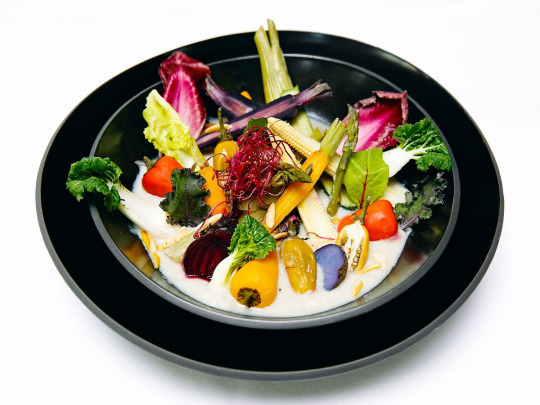
Steamed Vegetables with Sunchoke Sauce (Vegan)
#vegan#appetizer#lunch#endive#radicchio#sunchokes#jerusalem artichoke#asparagus#bok choy#fennel#carrots#celeriac#baby corn#bell peppers#zucchini#mushrooms#plant milk#sprouts#almonds#lemon#black pepper#sea salt#eat the rainbow
64 notes
·
View notes
Photo
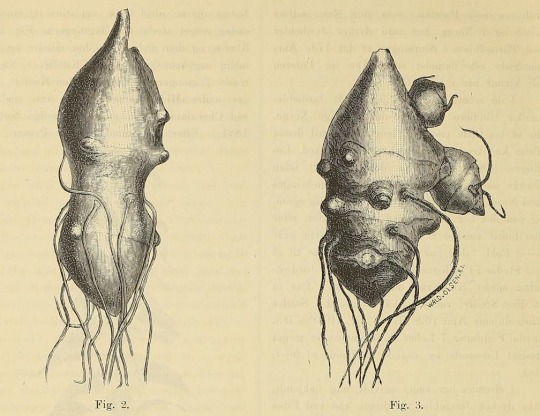
Illustrations of Jerusalem artichoke tubers from Naturen aarg.5 (1881).
Full text available here.
190 notes
·
View notes
Text


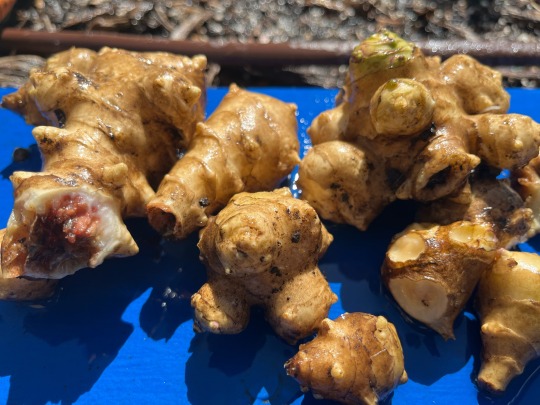
Harvesting sun chokes.
22 notes
·
View notes
Text

Our House
30 notes
·
View notes
Text
So I went to the field, to see if I could possibly locate the jerusalem artichoke; I'm craving it, but locating it is a little tricky. I know it's there, because I've seen the plant lady dig it out a few years ago, and the plant is invasive and aggressive and impossible to get rid of. I know during the summer, it looks like some sort of sunflower, it's related to sunflowers. I haven't exactly seen anything similar to sunflowers in the summer, but I was sick and not checking for the most of the time, so I wasn't sure if it flowered or not. There was one time the plant lady found it, and pointed at it and said 'Here, this is where you can dig for the jerusalem artichoke in the winter' and I still didn't see the sunflower-like plant, she was pointing at some grass. I tried really hard to remember the location, but there's very little to get oriented with in the field, and I only remembered that it was on the left side of it.
So. I'm standing in the big field with 10% hope that maybe I will find it. I tried to research 'how does the jerusalem artichoke look in the winter' and got absolutely nothing, only pictures of yellow flowers. I figured, maybe I'll see a stalk with a big dried flower, and that will be it. No such luck!
I'm checking the left side of the field. The only stalks I could see were those of the goldenrod, and that was easily recognizable. There were dry stalks of some other flowers as well, but always very tiny ones. I was looking for big flowers. There was blackberry, and tall grass. And some black, leafy stalks that looked a lot like goldenrod, but without the flowers on them.
I was suspicious about those, and I broke one off, to see if they were like goldenrod from the inside. They were different, more mushy. I decided to go and dig under that plant, based only on the premise that it was, on the left side on the field, and different to every other dried plant I could recognize.
And to my big surprise, it was the jerusalem artichoke! When I pulled a few of the stalks up, I was met with these big tubers, muddy and looking almost like ginger, which is how the artichoke looks like! I started laughing and wooing, because there was so little hope that I would be coming back home with food that day, and the stalks give nothing away, it literally looked like this:

To just randomly find delicious food digging under this? Feels like witchcraft.
I dug out just a few, and immediately had my hands filled with tubers. I didn't take pictures while digging because it was very cold, and I was extremely muddy and wet handling these, but I took a picture once I got home and cleaned them up. Here they are!

And this is just a bit, there's plenty more to dig out! They're both healthy and sating, their taste is exactly in the middle between a potato and an apple. My favourite way to eat them is pan fried, like you would do potatoes!
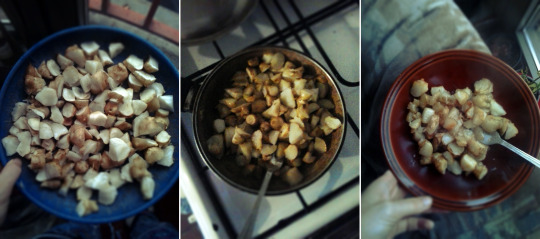
Now that I have these, I'll probably have jerusalem artichoke forever. Since the plant is so aggressive and asks for no upkeep, I can just plant this wherever I happen to live in the future, and they'll grow me new plants that need no looking after. I could plant these in the wild and they would still bring me winter food. Some things are just so cool like that.
59 notes
·
View notes
Text
Fried Jerusalem artichoke (cooking)

cooked
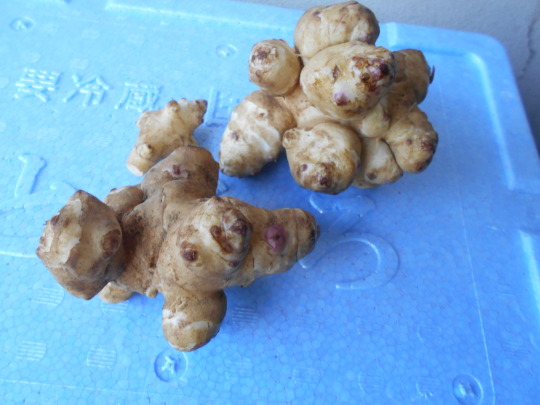
Original figure
Jerusalem artichoke (Asteraceae) is native to North Ameica, but it is also accepted in Japan and is sold at agricultural cooperatives. "Topinambur" in French. This time, it was sliced and deep-fried in olive oil. Fry for about 5 minutes, put in a bowl, mix 3 kinds of seasonings (salt, mace, and Korean red pepper) and sprinkle to complete. It was softer than expected and delicious.
(2022.11.18)
キクイモの揚げ物(料理)
キクイモ(キク科)は北アメリカが原産地だが、日本でも受け入れられて、農協などでも売っている。フランス語で「トピナンブール」。今回は、スライスし、オリーブオイルでヒタヒタの油で、揚げた。5分くらい揚げて、器に��り、塩、メース、韓国唐辛子の3種の調味料を混ぜて、ふりかけ、完成。予想以上に柔らかくなり、美味だった。
(2022.11.18)
#Jerusalem artichoke#fry#Asteraceae#キクイモ#North Ameica#Topinambur#mace#Korean red pepper#soft#cooking
10 notes
·
View notes
Text

In the fall, the bumblebees all converge on the huge sunchoke “bush” that grows in our backyard.
The crazy swirly background was accomplished in camera using the bokeh filter below.

Simply cut out of thin cardboard, the small holes act in the same way as the single hole in a regular bokeh filter would except that the multiple variously shaped bokeh it produces all overlap. The larger hole at the bottom provides a bokeh free area to shoot through. It is held in place by a cheap Cokin filter holder knockoff. Adjusting the filter up and down and rotating the filter holder gives some control over the position and amount of swirliness achieved.
Poste-processed with Affinity Photo v2, with the bumblebee and some of the flowers sharpened using Topaz Sharpen AI.
Camera: Pentax K-3
Lens: smc Pentax DA FA 1:2.8 100mm Macro
100mm / ƒ/5.6 / 1/400s / ISO 400
Taken: September 25, 2022
#original photographers#original photography#photographer on tumblr#photography#Marc-o-graphy#flowers#bumblebee#insect#diy#bokeh#filter#sunchoke#jerusalem artichoke#shallow DOF#canada#ontario#where i live#summer#June#2022#pentax#pentaxian#pentax k3#Affinity Photo#Topaz Sharpen AI
18 notes
·
View notes
Text
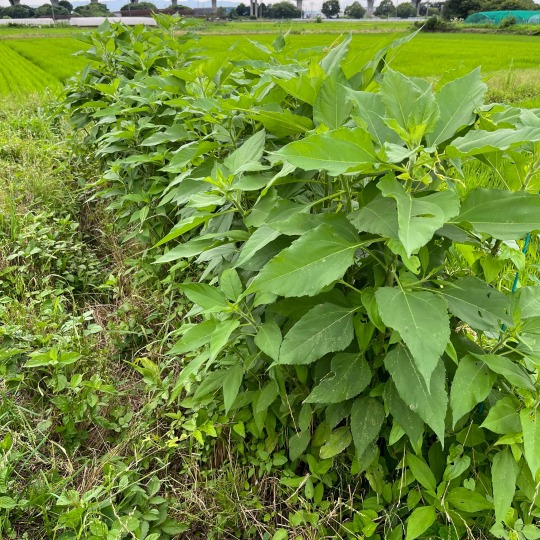
菊芋
2023/07/03
2 notes
·
View notes
Text
Edible (and Non-edible) Plants & Flowers Throughout the United States [Part 2]

The following plants, flowers and mushrooms can be found throughout the United States, so identifying and harvesting, as well as being able to identify their edible parts, is undoubtedly priceless information in the event of a SHTF situation. You should discuss the safety of ingesting these plants and flowers if you are pregnant and/or breastfeeding.
Go to Part 1.
Jerusalem Artichoke (Helianthus tuberosus)

How to identify it: This sunflower species has ovate leaves and can grow up to eight inches long and three inches wide. budding with many yellow disk flowers. Both leaves and stems have a rough, sandpapery texture.
Where to find it: Found in every state, but becomes more scarce in drier regions.
Edibility & flavor: Can be eaten raw or cooked. The white flesh is nutty, sweet and crunchy like chestnuts when raw. However, when baked in their skins, they more resemble potatoes with a mild taste of artichoke hearts.
Benefits: Rich in iron, potassium, Vitamin B1; regulates blood sugar levels; low in fats.
Caution: Has reportedly caused anaphylaxis in some people; otherwise, no other toxic or negative side-effects have been reported.
Lamb Quarters (Chenopodium album)

How to identify it: Also called wild spinach, fat hen, goosefoot, pigweed, etc., this edible weed is found nationwide all year long.
Where to find it: It's often found in agricultural fields, especially in low and wet areas that have been recently disturbed.
Edibility & flavor: Most of the plant -- flowers, leaves, and stems -- is edible. The seeds are also edible, but contain high levels of saponin and so shouldn't be eaten in excess.
Benefits: High in fiber, protein, Vitamin A, Vitamin C, manganese, calcium, copper, iron, omega-3 and omega-6 fatty acids.
Caution: Due to pesticides and other chemicals, Lamb's Quartrers can contain high levels of nitrates, oxalates, and sulfates.
Purslane (Portulaca oleracea)
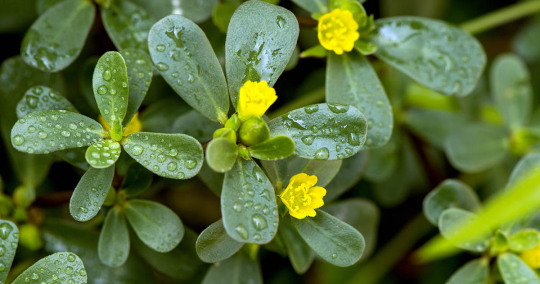
How to identify it: The stems are thick and succulent, reddish in color, and spread into dense mats up to 20 inches across. The leaves are also succulent and may be crowded enough to appear whorled or opposite.
Where to find it: Purslane grows just about anywhere, including gravel, sidewalk cracks, disturbed soil, and other "waste spaces."
Edibility & flavor: Best eaten raw and fresh, the way you'd eat spinach; however, it can also be cooked. It has a tart and slightly salty taste.
Benefits: Rich in omega-3 fatty acids; supports healthy arteries; helps prevent strokes, heart attacks, and other forms of heart disease.
Caution: Contains oxalates, which have been linked to kidney stones. Seeds have higher levels of oxalates than the rest of the plant. People prone to kidney problems should use caution.
Queen Anne's Lace (Daucus carota)
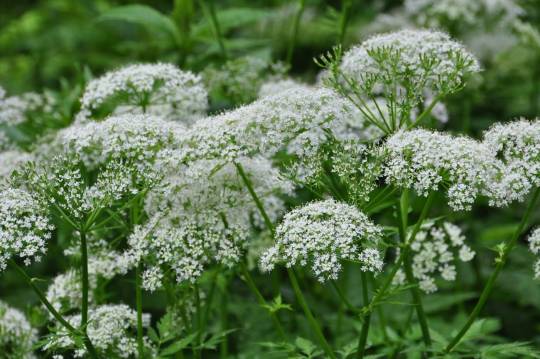
How to identify it: Also known as wild carrot, Queen Anne's Lace is a perennial that grows 1 to 4 feet tall and smells like carrots. It appears as a rosette in its first year. Umbrella-shaped flower clusters top one or several hairy hollow stems. Feathery, lacy leaves start immediately beneath the flower and increase in size as they descend. The flowers are actually tiny white individual flowers arranged in a flat-top umbel. The flowers bloom from May through October. The seeds are small, barbed, brown, oval and flat.
Where to find it: Commonly found in dry fields, roadside ditches and other open areas.
Edibility & flavor: The white flower heads and seeds are edible; if you catch them early enough, the roots and leaves are also edible. The roots, otherwise, are suitable only for flavoring. The flowers themselves taste vaguely fresh and carroty.
Benefits: The seeds have been historically used as contraceptives. The roots are used as a diuretic and prevent kidney stones and worms.
Caution: People with sensitive skin may develop irritation and blistering after contact with Queen Anne's Lace. Queen Anne's Lace also closely resembles hemlock, which is highly poisonous.
Self-Heal (Prunella vulgaris)
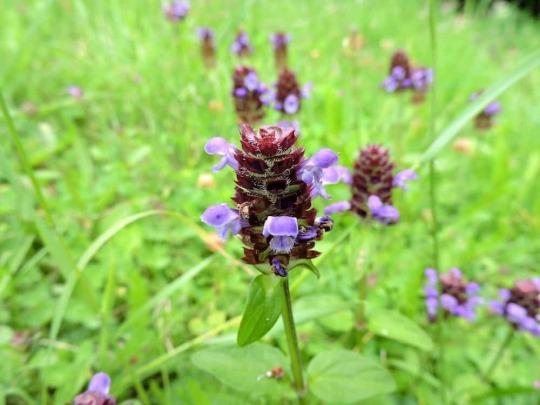
How to identify it: This perennial has a solitary or clustered upright stem and typically grows from 10 to 50 centimeters in height. The flowers are box-shaped and usually oblong in side-view; they're usually purple, but sometimes pink or white.
Where to find it:
Edibility & flavor: The entire flower tastes slightly bitter and slightly sweet like romaine lettuce, and can be eaten raw or cooked.
Benefits: Draws out infection; stimulates the healing of wounds, burns, and ulcers; has styptic effects and can staunch the flow of blood.
Caution: None noted.
Stinging Nettles (Urtica dioica)

How to identify it: Grows in dense clusters of stalks 5 to 8 feet tall. The leaves are heart-shaped, pointed at the tips, have indented veins, and get about 2 to 5 inches long.
Where to find it: Can be found everywhere nationwide beginning in early spring; the best places to find them are sunny areas with rich, moist soil, such as along rivers, streams, lakes, ditches, fencerows and the edges of cultivated fields.
Edibility & flavor: Stinging nettles can be eaten raw or cooked; if being eaten raw, however, make sure to neutralize the nettle leaves by cooking or drying them, or crushing them with your teeth or tools (like a mortar and pestle) so they cannot sting you with formic acid. The leaves are edible at any stage of growth -- if they've already grown flowers and seeds, though, the smaller leaves at the top are still safely edible. Nettles have a rich, earthy, spinach-like flavor with a slight tang.
Benefits: They contain many nutrients; reduce inflammation; treat enlarged prostates; treat hay fever; lowers blood pressure; and helps regulate blood sugar.
Caution: Handle with care, as the barbs of stinging nettles can inject not just formic acid, but also possibly an array of other chemicals, such as serotonin, acetylcholine, histamine, and/or leukotrines -- these can cause skin irritation, such as itchiness, rash, bumps, and/or hives. If processed correctly before ingesting, these chemicals will be neutralized and shouldn't cause intestinal distress. Consult with a physician before ingesting if you take certain medications, such as blood thinners, blood pressure medication, diuretics (or water pills), diabetes medication, or lithium.
Watercress (Nasturtium officinale)
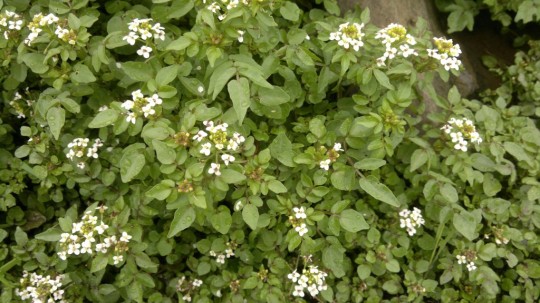
How to identify it: The flowers of watercress are small, white, and grow in long clusters similar to mustard. Watercress is glossy-looking, mostly hairless, medium-sized, and can be aquatic or sub-aquatic. It is sometimes confused for garden cress (or mustard cress), fool's watercress, land cress (or pepper cress), nasturtium, and pea shoots.
Where to find it: Commonly found in cold, alkaline waters, such as those of springs, spring runs, and streams.
Edibility & flavor: Can be eaten raw or cooked, though raw is best. How it is eaten will also determine its taste -- raw, it will have a peppery taste similar to mustards or wasabi. Cooked, it will lose the pepperiness, leaving a distinctively vegetable flavor.
Benefits: Rich in potassium and is considered a "superfood" with 49 other rich nutrients believed to lower one's risk of cancer; improve heart health, and support bone health.
Caution: Eaten raw can infest one with parasitic liver flukes, which can enlarge the liver within the first stages of infestation and later lead to severe pain in the upper abdomen, jaundice, and sometimes skin inflammation.
Wild Strawberries (Fragaria virginiana)

How to identify it: These are easy to spot because their leaves have toothed edges and hairy undersides, and of course, the distinctive red, seeded fruit. Sometimes can be misidentified because they look just like "mock strawberries" -- however, mock strawberries aren't poisonous, so misidentification of these two plants will not be fatal.
Where to find it: Prefer dry locales with rich, loamy soil, such as wood edges, yards and along roadsides.
Edibility & flavor: Can be eaten raw or cooked. Wild strawberries have the same sweet, aromatic, slightly floral, gently acidic taste as those you can buy in grocery stores.
Benefits: Excellent sources of potassium and fiber; helps lower blood pressure and reduce risks of developing osteoporosis.
Caution: None noted.
#shtf plan#edible plants#edible flowers#f&d#food and drink#outdrs#foraging#gardening#prep#prepper#prepping#survival#survivalism#survivalist#off the grid#offgrid#part 2#jerusalem artichoke#lamb quarters#purslane#queen anne's lace#self-heal#stinging nettles#watercress#wild strawberries
28 notes
·
View notes
Text
Silo
A zero waste restaurant is an interesting concept. What makes this concept even more exciting is how far you take this.
Is it purely in relation to the food? Using off cuts? The whole hog? In which case, St Johns already has you beat.
Or does it extend to what you do with the packaging? You can grind down glass bottles and repurpose these into glasses if you own an on site kiln.
However,…
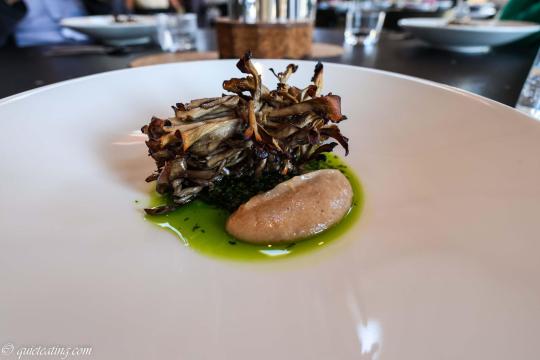
View On WordPress
#bread and butter#heritage carrots#ice cream sandwich#jerusalem artichoke#leeks#maitake mushroom#miso#pig&039;s head#quavers#sourdough
2 notes
·
View notes
Text
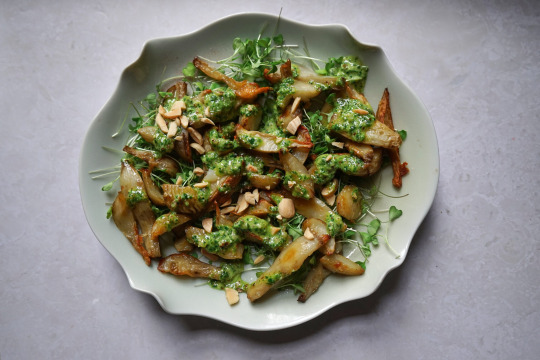
Roasted Jerusalem Artichoke & Arugula Pesto (Vegan)
#vegan#appetizer#roasted vegetables#sauces#sunchokes#jerusalem artichoke#pesto#arugula#almonds#lemon#olive oil#black pepper#sea salt#microgreens#💚#🤍
12 notes
·
View notes
Text

Had to bring the sunchokes in because they were making bad decisions outside despite multiple freezes & snows. They've slready grown to cover the hole in my bathroom wall
3 notes
·
View notes
Text

Jerusalem artichoke in South Central Los Angeles. It’s actually from the sunflower family and has an edible root.
17 notes
·
View notes
Text

Next to You
33 notes
·
View notes
Text

🌼🌼🌼
11 notes
·
View notes
